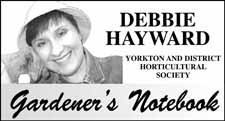You know how you feel when you hear the first lawnmower in the spring? It's like the herald that a new season has arrived. I felt that way the other day when I heard a garden tiller going somewhere in the neighborhood. It signalled to me that this year's growing season was over, and fall has arrived.
To till or no to till? There are advantages to both, and if you ask ten gardeners if you should till your garden in the fall, you'll likely get ten different answers. So let's look at the reasons why we should till our gardens in the fall. It helps to clean up the yard: we can work dried leaves or other organic matter into the soil. Turning the soil will aerate it and help organic matter break down. The furrows will trap snow over winter for moisture in the spring. By tilling our gardens now, we can start our gardens earlier in the spring: we don't have to wait for the soil to dry then to get the ground worked. Plus, that patch of nice black earth looks so great at this time of year, doesn't it!
But on the other side of the coin is the argument for not tilling. My favorite gardening guru, Marjorie Harris, says she rarely digs in her garden anymore. She finds that disturbing the soil seems to bring new weed seeds to the surface, so she keeps her digging to a minimum. And while I was doing my homework about tilling or not tilling, I found an interesting article about something called "lasagna gardening".
Before we get out the crusty bread and tie bibs around our necks, I should explain that lasagna gardening refers to a method of gardening where layers or material are added to build up your garden as they break down. Lasagna gardening is organic, and does not involve any digging or tilling. We would use certain "ingredients", and put them in our garden in a certain order. Some ingredients would include leaves, vegetable and fruit peels, grass clippings, manure, compost and peat moss. We would add these to our garden much the same as we would to a compost pile: a layer of green ingredients, like peels or grass clippings, then a layer of brown ingredients, such as leaves, manure or peat moss. If we did the lasagna method in our gardens now, these lovely layers would break down all winter. Then in the spring, when it's time to do our planting, we would just go ahead and make our rows as normal, then top-dress with a layer of compost or topsoil.
This is a method that is definitely adventurous, and a little unusual. Some gardeners might not like the look of this, because it wouldn't have the look of a neatly tilled garden. But it might be fun to try it just in one area just to see how it compares. It would certainly be healthy for the soil, and I think we still need to amend our soils to stengthen and aerate them after the summer of 2010. I know parts of our garden were very hard and difficult to work.
The Yorkton and District Horticultural Society will be holding their annual general meeting on Wednesday, November 23 at the Legion. This is our evening to enjoy a delicious meal, enjoy the fun of the silent auction, and then we'll head across the pond as Keith and I do a presentation on bonny Scotland! This is a members only meeting, but hort members, you can bring a guest. Just call Liz at 782-2830 as soon as possible, because we'll need numbers for supper. It's always a great time, so we hope that all horticultural club members can join us. That's November 23.
Till next time, have a great week, and get out and enjoy your yard! It's an adventure to sit out for a few minutes in a parka, and enjoy the crisp air, the glorious colors of autumn, and a cup o' coffee!




